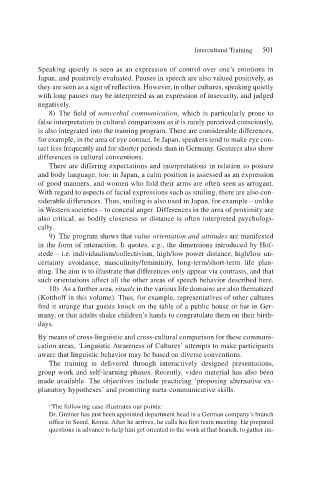Page 523 - Handbooks of Applied Linguistics Communication Competence Language and Communication Problems Practical Solutions
P. 523
Intercultural Training 501
Speaking quietly is seen as an expression of control over one’s emotions in
Japan, and positively evaluated. Pauses in speech are also valued positively, as
they are seen as a sign of reflection. However, in other cultures, speaking quietly
with long pauses may be interpreted as an expression of insecurity, and judged
negatively.
8) The field of nonverbal communication, which is particularly prone to
false interpretation in cultural comparisons as it is rarely perceived consciously,
is also integrated into the training program. There are considerable differences,
for example, in the area of eye contact. In Japan, speakers tend to make eye con-
tact less frequently and for shorter periods than in Germany. Gestures also show
differences in cultural conventions.
There are differing expectations and interpretations in relation to posture
and body language, too: in Japan, a calm position is assessed as an expression
of good manners, and women who fold their arms are often seen as arrogant.
With regard to aspects of facial expressions such as smiling, there are also con-
siderable differences. Thus, smiling is also used in Japan, for example – unlike
in Western societies – to conceal anger. Differences in the area of proximity are
also critical, as bodily closeness or distance is often interpreted psychologi-
cally.
9) The program shows that value orientation and attitudes are manifested
in the form of interaction. It quotes, e.g., the dimensions introduced by Hof-
stede – i.e. individualism/collectivism, high/low power distance, high/low un-
certainty avoidance, masculinity/femininity, long-term/short-term life plan-
ning. The aim is to illustrate that differences only appear via contrasts, and that
such orientations affect all the other areas of speech behavior described here.
10) As a further area, rituals in the various life domains are also thematized
(Kotthoff in this volume). Thus, for example, representatives of other cultures
find it strange that guests knock on the table of a public house or bar in Ger-
many, or that adults shake children’s hands to congratulate them on their birth-
days.
By means of cross-linguistic and cross-cultural comparison for these communi-
cation areas, ‘Linguistic Awareness of Cultures’ attempts to make participants
aware that linguistic behavior may be based on diverse conventions.
The training is delivered through interactively designed presentations,
group work and self-learning phases. Recently, video material has also been
made available. The objectives include practicing ‘proposing alternative ex-
planatory hypotheses’ and promoting meta-communicative skills.
“The following case illustrates our points:
Dr. Greiner has just been appointed department head in a German company’s branch
office in Seoul, Korea. After he arrives, he calls his first team meeting. He prepared
questions in advance to help him get oriented to the work at that branch, to gather im-

